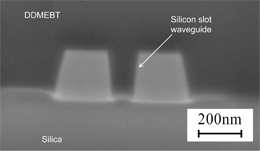Wednesday, April 15th, 2009
The first example of all-optical signal processing for communication above 100Gbit/s using silicon-based devices has been published in the April issue of Nature Photonics. Using deep-ultraviolet lithography, standard CMOS processing and organic molecular beam deposition, researchers from the University of Karlsruhe, IMEC and its associated laboratory INTEC at Ghent University, Lehigh University and ETH Zurich have now fabricated an innovative optical waveguide structure termed a silicon-organic hybrid (SOH).
Today’s fiber-optic communication technology can transmit information across continents, but switching still requires converting the optical signals back to electronic data for processing. All-optical signal processing would overcome a serious bottleneck in such telecommunications applications, where speed, power and cost are crucial. An optical waveguide switch in which one light signal can direct the propagation of another would be a key element to enabling all-optical processing. However, while photonic technology can be ultra fast, the photon-photon interactions in known materials and structures has been too weak to be practical.
A 4mm long SOH waveguide proved the capability of the SOH concept (see figure). With these waveguides, all-optical demultiplexing of a 170.8Gbit/s telecommunication signal to 42.7Gbit/s was performed using four-wave mixing. This is the fastest silicon photonic optical signal processing demonstrated to date. In the four wave mixing process, a new wavelength is generated by combining the signal and control wavelengths. A dispersive coupling element can then separate this new wavelength and direct it to a different optical fiber. By pulsing the control wavelengths at a lower data rate than the signal, each compontent of a highly multiplexed signal can be selected. This experiment proved the viability of the SOH waveguides for all-optical processing of broadband telecommunication signals. More information on this breakthrough technology will be in the next BetaSights Newsletter. –M.D.L.

